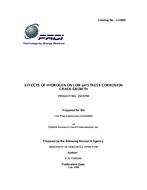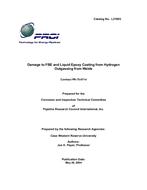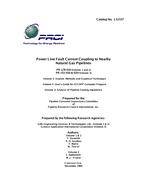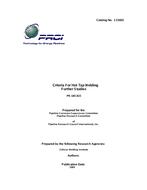Provide PDF Format
PRCI PR-232-9704
- Effects of Hydrogen on Low-pH Stress Corrosion Crack Growth
- Report / Survey by Pipeline Research Council International, 07/01/1998
- Publisher: PRCI
$298.00$595.00
L51806e
University of Newcastle upon Tyne
Need: There is circumstantial evidence of hydrogen playing a role in, so called, low pH SCC of pipeline steel, but direct evidence for such is lacking. Resolution of this situation is of practical importance because of its implications for modeling. Thus, existing models for high pH SCC of pipelines are based upon a dissolution controlled mechanism of crack growth, but such models will not be applicable to low pH SCC if hydrogen is involved with the latter.
Benefit: Measurements have been made of the permeation of hydrogen into X52 and X60 pipeline steels at various potetials while exposed to a simulated ground water containing different amounts of carbon dioxide, related to the conditions thought to be associated with transgranular stress corrosion cracking of pipelines. As a consequence of these measurements it is now known unequivocally that hydrogen enters the steel for all such solutions over wide ranges of potential, including those most likely involved in the cracking of pipelines, and with such entry enhanced as the amount of carbon dioxide present in the solution increased. For a given set of environmental conditions, it was found that films on the surface of the pipe, such as may exist in service conditions, could hinder, but not prevent, the ingress of hydrogen. Hydrogen in steel is usually regarded as being trapped at dislocations, grain boundaries or interfaces between the matrix and second phase particles and measurements relating to such indicate that the X60 steel contains appreciably fewer traps than the X52 steel for equivalent charging conditions. However, the trapped hydrogen was found to have no significant influence on the ductility of the steels when subsequently tested in air, although the ductility was impaired by thxe continued ingress of hydrogen when equivalent tests were conducted in the presence of the charging solution. No convincing evidence has been obtained for the ingress of hydrogen into the steels facilitating the early stages of plasticity under exposure conditions relating to those involved in low pH stress corrossion cracking. The most probable mechanism of stress corrosion crack growth in pipeline steel in the solutions studied and at potentials likely to obtain in service involves both dissolution and hydrogen ingress to the steel, although the interactions of those two factors in the fracture process remain speculative.
Result: The results show that hydrogen enters the steel for all such solutions over wide ranges of potential, and that permeation increases with increasing carbon dioxide content. Also, for a given set of environmental conditions, it was found that films on the pipeline service can hinder, but not prevent, the ingress of hydrogen. Based on the results of this study, the most probable mechanism of stress corrosion crack growth involves dissolution and hydrogen ingress to the steel, although the interaction of these two parameters in the fracture process remains speculative.
University of Newcastle upon Tyne
Need: There is circumstantial evidence of hydrogen playing a role in, so called, low pH SCC of pipeline steel, but direct evidence for such is lacking. Resolution of this situation is of practical importance because of its implications for modeling. Thus, existing models for high pH SCC of pipelines are based upon a dissolution controlled mechanism of crack growth, but such models will not be applicable to low pH SCC if hydrogen is involved with the latter.
Benefit: Measurements have been made of the permeation of hydrogen into X52 and X60 pipeline steels at various potetials while exposed to a simulated ground water containing different amounts of carbon dioxide, related to the conditions thought to be associated with transgranular stress corrosion cracking of pipelines. As a consequence of these measurements it is now known unequivocally that hydrogen enters the steel for all such solutions over wide ranges of potential, including those most likely involved in the cracking of pipelines, and with such entry enhanced as the amount of carbon dioxide present in the solution increased. For a given set of environmental conditions, it was found that films on the surface of the pipe, such as may exist in service conditions, could hinder, but not prevent, the ingress of hydrogen. Hydrogen in steel is usually regarded as being trapped at dislocations, grain boundaries or interfaces between the matrix and second phase particles and measurements relating to such indicate that the X60 steel contains appreciably fewer traps than the X52 steel for equivalent charging conditions. However, the trapped hydrogen was found to have no significant influence on the ductility of the steels when subsequently tested in air, although the ductility was impaired by thxe continued ingress of hydrogen when equivalent tests were conducted in the presence of the charging solution. No convincing evidence has been obtained for the ingress of hydrogen into the steels facilitating the early stages of plasticity under exposure conditions relating to those involved in low pH stress corrossion cracking. The most probable mechanism of stress corrosion crack growth in pipeline steel in the solutions studied and at potentials likely to obtain in service involves both dissolution and hydrogen ingress to the steel, although the interactions of those two factors in the fracture process remain speculative.
Result: The results show that hydrogen enters the steel for all such solutions over wide ranges of potential, and that permeation increases with increasing carbon dioxide content. Also, for a given set of environmental conditions, it was found that films on the pipeline service can hinder, but not prevent, the ingress of hydrogen. Based on the results of this study, the most probable mechanism of stress corrosion crack growth involves dissolution and hydrogen ingress to the steel, although the interaction of these two parameters in the fracture process remains speculative.
Related Products
PRCI PR-75-9714
Damage to FBE and Liquid Epoxy Coating from Hydrogen Outgassing from Welds..
$50.00 $99.00





